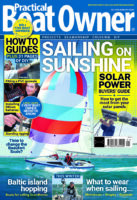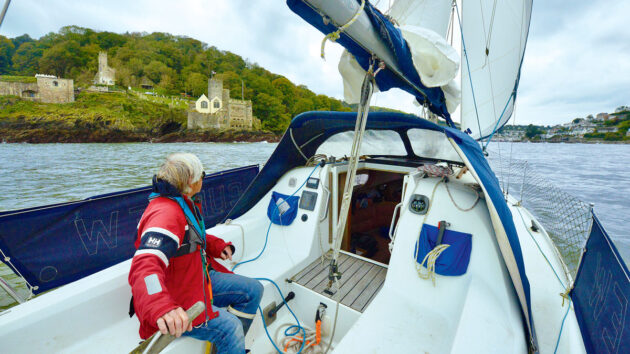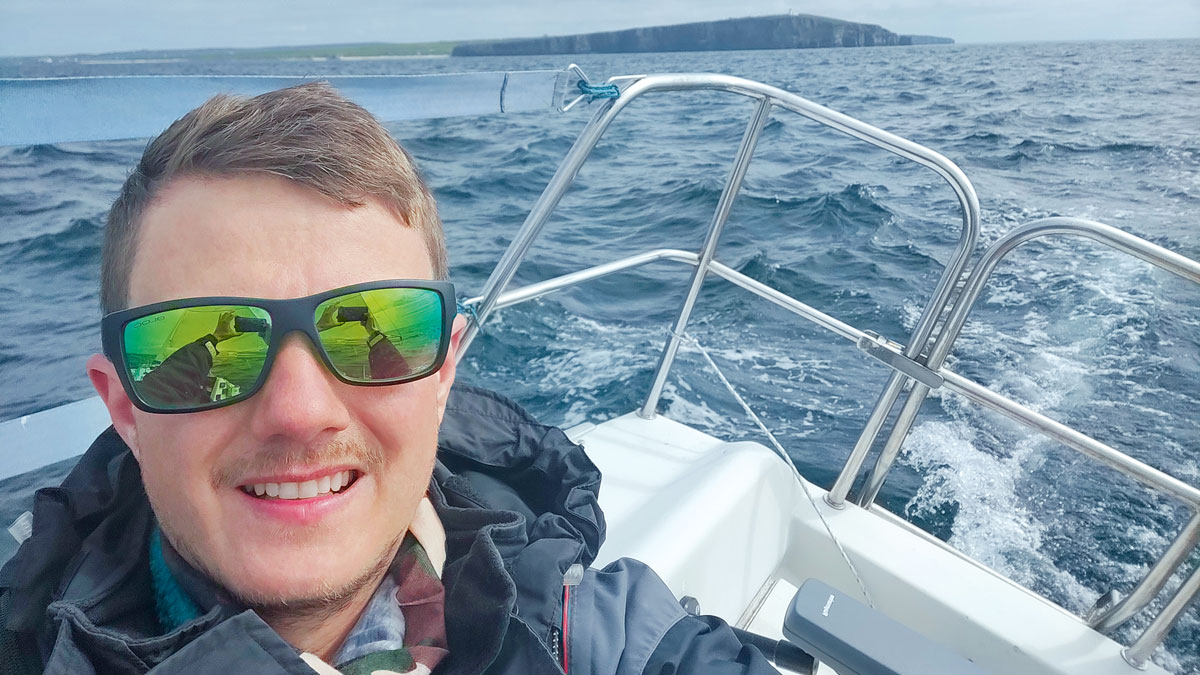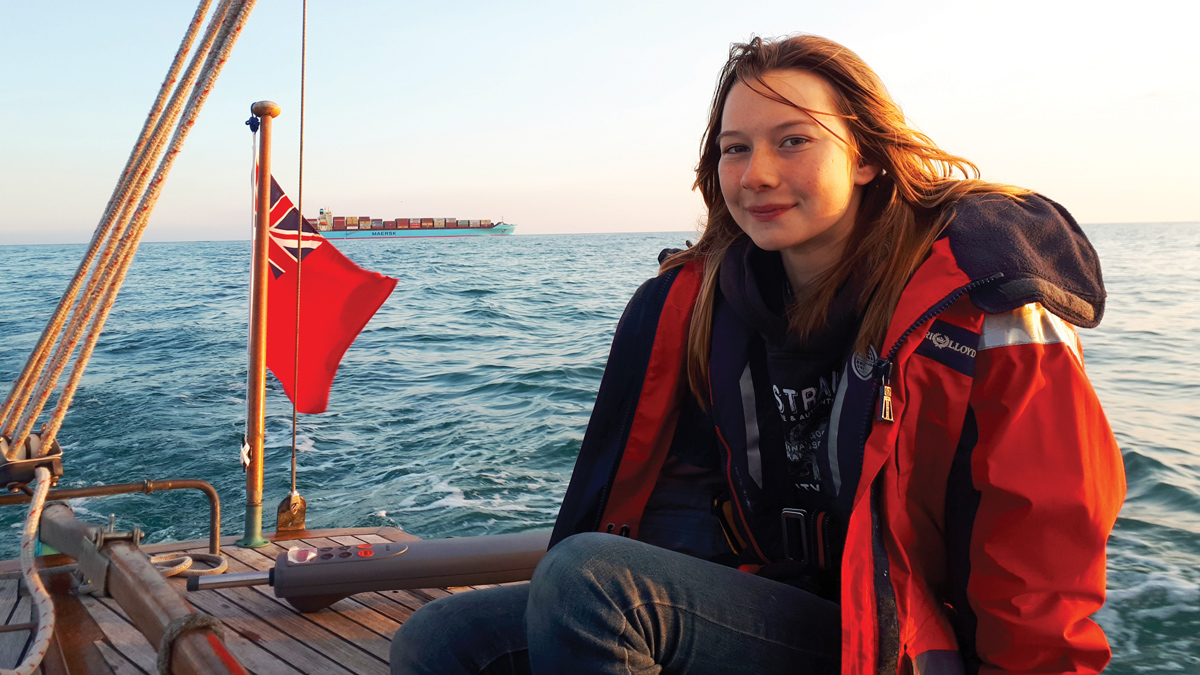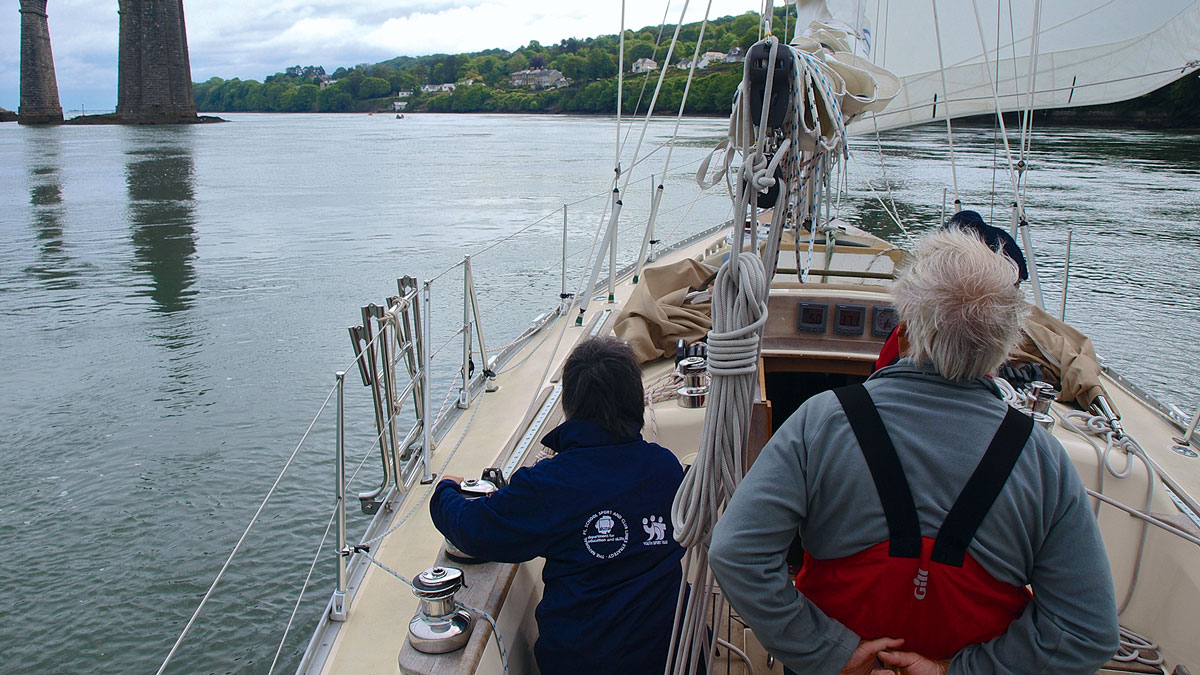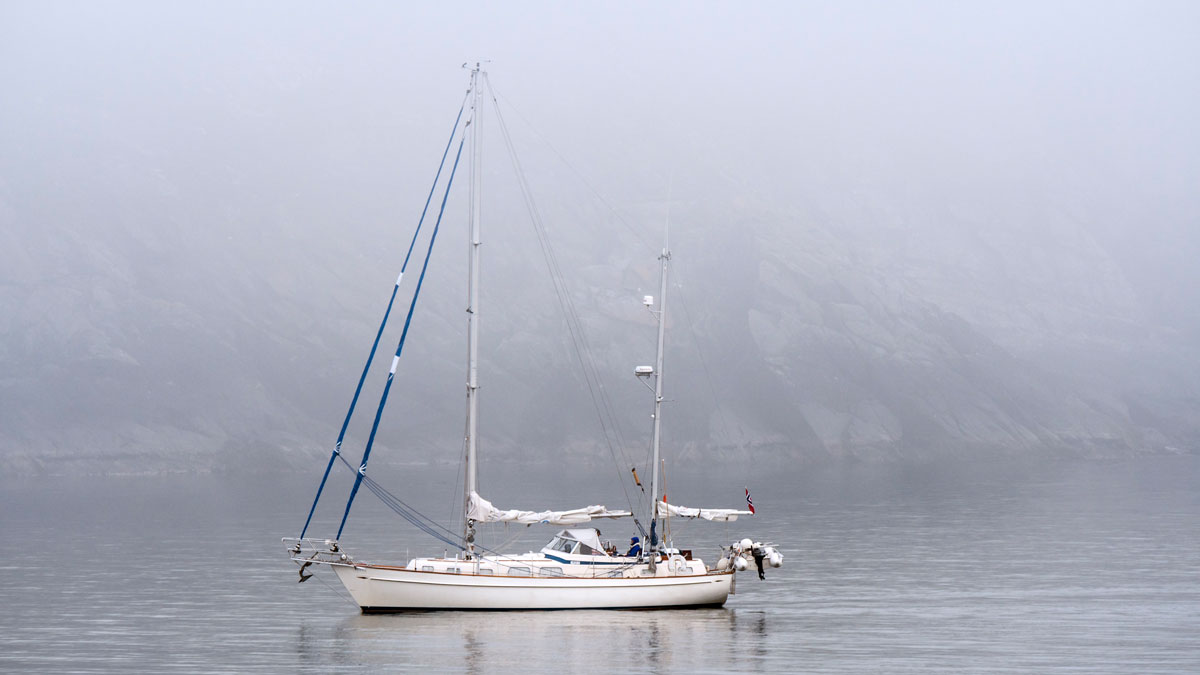Sam Steele explains everything you need to know about a circumnavigation of Britain and Ireland
There inevitably comes a moment on most summer cruises when you must decide when to turn around and head home, writes Sam Steele.
The pressure of schedules and responsibilities reminds you that your holiday has a finite end.
But imagine if you could continue exploring new waters?
While the idea of venturing into exotic, far-off waters may be tempting, turning that dream into reality often requires major sacrifices – like selling your home
However, we tend to forget that some of the world’s most spectacular cruising grounds are right on our doorstep.

Sailing around the UK and Ireland can take you to remote anchorages, like Worbarrow Bay (pictured) on the English south coast. Credit: Sam Steele
A circumnavigation around the UK and Ireland, or a Round Britain adventure, offers the perfect challenge.
Advantages of a circumnavigation close to home
- With so many harbours to choose from, you can easily hop along the coast, with only a few overnight passages needed.
- You are never too far away from home in case of emergencies.
- Remote working means that for some, it might even be possible to work from your boat.
- Unlike bluewater cruising, coastal cruising requires less self-reliance since many harbours have skilled mechanics on hand.
- In Ireland, you are not constrained by the 90 days within 180-day rule that applies when cruising in other European countries.
Mags Campbell and I sailed around Britain in Ituna, our Rival 38. The journey took us 115 days from May to August, covering just under 2,200 miles.
Along the way, we spent two full nights sailing, nine nights at anchor, 13 nights on buoys, 32 nights on pontoons, 46 nights in marinas, and 11 nights against walls (without drying out).
Upon our return, I realised there was little information about sailing round our coast. So I set about writing the UK and Ireland Circumnavigator’s Guide.
But to ensure I gathered the experience of others, I surveyed 69 other circumnavigators, who’d completed the various routes.
Which route to sail around the UK and Ireland?
There are three major route decisions you’ll have to consider.
- Do you circumnavigate Ireland?
- Do you take a shortcut through a canal in Scotland?
- Do you go clockwise or anticlockwise?
Circumnavigating Ireland offers some truly spectacular scenery, but the long, rolling Atlantic swell can present a challenge.
Although it’s only an additional 300 miles compared to sailing around Britain, you may find yourself delayed, waiting in the lee of the many headlands due to adverse weather conditions.
As for the question of going clockwise or anticlockwise, there are advantages to both.
The prevailing currents are relatively weak and favour a clockwise direction except for the south coast.

Sail around the UK and Ireland: Celebrate passing the milestones, like the Fastnet Rock. Credit: Graham Snook/Future
When considering the prevailing winds, there are several factors to account for: your starting point, the percentage likelihood of wind strength and direction, and importantly, the timing of your arrival at key locations, which could influence your chosen direction.
On the west coast of Ireland, the Atlantic swell and onshore winds tend to increase from June onwards, so it’s wise not to arrive too late in the season.
Spring is the driest season, with May being the sunniest month in Ireland. Similarly, May, June, and July are ideal for exploring the west coast of Scotland, before the onset of autumn gales.
These factors often play a crucial role in determining your route.
Most sailors based on the South Coast set off heading west, while those on the East Coast may head either north or south.
Canals
Using canals provides a welcome change of pace, a chance to relax and enjoy the scenery, as well as serving as a shortcut.

Transit times and costs for canals for a sail around the UK and Ireland
Be aware that canals are freshwater, so you’ll need to account for an additional 10cm on your draught.
Depths can vary, so it’s always a good idea to contact the sea lock keepers in advance to confirm conditions. www.scottishcanals.co.uk
- The Caledonian Canal: if time is tight, the ‘Caley’ canal can save you up to 500 miles. The advantage comes not only from the shorter distance but also from the added shelter, although the wind can funnel down the glens. The canal is 60 miles long, stretching from Fort William to Inverness, and follows the natural fault line of the Great Glen through the Scottish Highlands. Completed in 1822, it took 19 years to build the 22 miles of man-made canal, all dug by hand with picks and shovels. It was Britain’s first state-funded transport project, setting the precedent for many to come as it was both over budget and behind schedule!
- The Crinan Canal: known as ‘Scotland’s prettiest shortcut,’ the Crinan Canal meanders from Ardrishaig on Loch Fyne to Crinan. While it doesn’t significantly shorten the distance, it allows you to bypass the challenging Mull of Kintyre, which requires careful planning to navigate the tides. Even in summer, this stretch can experience stormy conditions.
- Forth and Clyde Canal: from the Clyde to the Forth, this route offers a mix of bustling towns and tranquil countryside, though you’ll need to remove your mast along the way. You’ll pass by the Falkirk Wheel, the world’s first rotating boat lift.
Transiting the canals
Top tip if taking the Caledonian Canal Don’t just take the shortest route if entering or exiting the Caledonian Canal on the west coast of Scotland.
Plan to go north of Loch Linnhe to explore, otherwise, you’ll be missing out on some of the most spectacular cruising areas in Britain.
Top tip if sailing around Britain
Plan to spend as much time as possible on the west coast of Scotland. We only spent 25% of our four-month trip, we wished we had spent more – a common sentiment.

Routes to sail around the UK and Ireland

Key for the chart above
How long does it take to sail around the UK and Ireland?
The UK and Ireland sailing record stands at just over three days, but for most, the attraction is exploring new waters, though the length of the cruise is likely to be dictated by factors such as work, finance etc.
Therefore, it will have to be a balance between how much time you have, the route you choose, the number of stops you wish to make and the weather you’re prepared to venture out into.

The different routes and the time it takes to sail around the UK and Ireland
The shorter your time frame, the greater the pressure will be to keep moving.
Even with a four-month cruise, you’ll still feel the pressure to move on whenever you can. Most people take between 86 to 95 days regardless of route, but these are averages.
One crew, in their Maxi 1100 with a crew of four, rounded the UK and Ireland in 34 days, visiting 23 harbours with 31 days at sea.
Their biggest frustration was not having enough time to explore!
Definitions
The name for the route you complete can spark hours of debate, it’s quite a challenge to accurately describe it.
For precise definitions, please refer to www.sailingwithcarra.com/uk-and-ireland/definitions/.
However, for the purposes of this article, I’ve simplified them. Regardless of your route, completing it is an incredible achievement.
Short of time?
If you’re short on time, there are several options to consider. You could reduce the number of stops, and sail longer legs, pressing on quickly through areas you know well.
Having more crew for these stretches would help reduce fatigue. Alternatively, you could break the journey into long weekends or holiday periods, or even split it over several years, overwintering at different locations.
One couple broke their journey round Britain into 11 long weeks, sailing a total of 30 days over 13 months and covering 1,446 miles.
When to leave to sail around the UK and Ireland
From April to the end of September is the most popular window for most yachts, as there are typically fewer gales between May and August.
According to the Met Office’s and Met Éireann’s data, based on a 30-year average, there are usually fewer than one gale day per month during this period (with the exception of Malin Head, which averages two gale days).
That’s the theory, but of course, a 30-year average is just that—an average. ]
Regardless of route or direction, about a third of people surveyed typically set off within the first two weeks of May.
Top tip for insurance
Many boat insurance companies include Ireland in home waters, but do check.
Also, be aware that if you are sailing single-handed some insurers limit the passage hours, to only 18 or 24 hours, so you might need to shop around.
How much does it cost to sail around the UK and Ireland?
Without food and money spent ashore for leisure activities, expect to pay £19 to £35 a day for a 36ft boat based on recent surveys.
Harbour fees are a major cost, but a variable that you can influence: Anchor more – especially in the south-west coast of Ireland and west coast of Scotland where you are spoilt for choice.

Keep the cost of your circumnavigation down by anchoring as much as possible – this is Puilladobhrain on Scotland’s west coast. Credit: Sam Steele
One yacht crew, whose daily cost was £19, anchored 45% of their time, and at the other end, the person who spent £35 a day, anchored for only 3% of their time.
Reduce the amount of time in marinas on the south coast of England – where costs are at least 1.6 times the average of elsewhere.
Additional costs are approximately £1,000 to £1,200 for electronic charts and paper charts, tidal atlases, Reeds Almanac and pilot books.
Provisioning
Gas in Ireland
Finding UK Calor gas in Ireland further west than Kinsale is difficult. Calor Gas Ireland’s smallest 4.5kg bottle is larger and has a different connection to the British equivalent.
If you are likely to need to buy gas in Ireland, plan to carry extra or use Campingaz, which although it is more readily available, is still relatively scarce.

If you plan to sail to Ireland, remember that red diesel is banned
Be aware that the smaller 2.72kg Campingaz cylinder has a wider base and needs a different regulator.
Food
Before heading to the more remote areas, particularly in some parts of the west coast of Ireland and Scotland, be sure to stock up at the larger shops.
While you’ll find village shops along the way, the selection can be limited.
Visiting Ireland
If you’re planning to visit Ireland, you need to be aware of certain rules:
- Crew: the Republic of Ireland is not part of Schengen but belongs to the common travel area, which thankfully means the 90/180 restriction doesn’t apply. So you can spend as much time in Ireland as you wish – but you will need your passports.
- Boat VAT Status: a UK VAT-registered boat can only spend 18 months in Ireland, if it was in the UK on 31 December 2020.
- Procedure: on entering Irish waters you must fly a Q flag, and the crew remain on board until the skipper has completed necessary customs and immigration formalities, then, the Q flag can be taken down. You will need the ship’s papers, proof of ownership and where your boat was on 31 December 2020. Contact Customs and the harbourmaster on arrival. The actual experience appears to be more relaxed, often the Customs response is that they’ll visit when they are in the area. But always go with the correct procedure.
- Waste: food waste from the UK is treated as international catering waste (ICW), which requires special disposal. Minimise the amount of food waste you take into Ireland and separate it from your normal rubbish.
- Red diesel Is not permitted in Ireland, only unmarked diesel is allowed.
- Returning to the UK: re-entering UK waters, you need to complete a Pleasure Craft Report (sPCR) either online or by posting and flying a Q flag. Departing the UK, you need to complete a pleasure craft report.
Challenges on a sail around the UK and Ireland
This cruise will challenge your navigation skills, with strong tides, tidal gates, rocks, and sandbanks, all compounded by varying degrees of visibility.
However, a circumnavigation requires more than just qualifications or experience. To succeed, you’ll need a range of additional skills, including the ability to maintain your boat and equipment over an extended period.

Make sure you take the spares you need for your engine and other systems on board. Credit: Jon Mendez
Unfortunately, you may find yourself motoring more than you might expect—survey respondents report spending an average of 52% of their time motoring or motor-sailing.
Your engine will therefore be crucial to your success, so it’s essential to ensure it’s well-maintained and that you have the right spares on board.
Organisation is also key – getting to the starting line requires careful planning, from preparing your boat and gathering the necessary equipment to provisioning and arranging for an extended absence from your home.
How will you manage your mail? Does your home insurance cover extended periods of absence?
Some essential gear
- A fender board to protect topsides and fenders from the stone walls and tyres that can be found in canals and traditional harbours.
- Given the additional mileage, take adequate engine consumables e.g. oil, fuel, oil filters, and impellers for changes.
- Other spares – being in remote parts of Ireland or Britain does make getting spares a challenge which can cost precious time – so work out what spares make sense for your boat systems.
Hazards
Nearly 50% of those surveyed identified lobster pots as a significant hazard. You will see the good, the bad and the ugly in terms of pot markers.
Given this, it’s essential not only to keep a sharp lookout, but also to have a clear plan for what to do if you become entangled with one.
We caught one on a windless day off the coast of mainland Orkney, thankfully the tide was taking us away from any danger otherwise we would have radioed for help.

Make sure you have a clear plan to deal with lobster pot entanglement
I had purposely brought the wetsuit to fit Mags, as I figured that growing up in Scotland, she’d be used to the water temperature!
But it was so cold it caused her to hyperventilate. It took a while to regulate her breathing.
After which she dived under the boat to find that the rope had neatly missed the rope cutter.
We successfully freed ourselves and the engine was undamaged but we learnt several lessons that day:
- Brief your crew in advance about what to do – I hadn’t told her to stop the engine as soon as we caught a line.
- Don’t just cut the buoy free and drop the line. If you tie the line off – you then have a fixed line to pull yourself under the water to the propeller.
- Don’t enter the water in anything more than sea state slight. Above, this could result in having a casualty in the water, with a head injury from hitting the bottom of the boat.
- Tie the knife to your wrist. Mags put it down in 60m of water while she untied the rope… she returned with the bread knife tied to her wrist!
Rewards
There are many rewards of this trip: the milestones that bring a true sense of achievement when you pass them: Land’s End; Ardnamurchan Point, mainland Britain’s most westerly point and north of which you’ll see white beaches and aqua blue waters; Cape Wrath, the north-westernmost point of mainland Britain; and, if you circumnavigate Ireland, the Fastnet Lighthouse and the Dingle Peninsula, Europe’s most westerly point.
Another highlight is the diverse range of harbours and anchorages you’ll encounter.
This is especially striking if you’re accustomed to sailing in busy, crowded waters where marinas are the norm and peaceful anchorages are hard to come by.
On your journey, you’ll need to be prepared for a variety of mooring situations: anchoring, buoys, pontoons, marinas, and quay walls.
You will be able to avoid drying out, if you want to.

Cruising the Dingle Peninsula and the rest of Ireland is not subject to the 90/180-day Schengen rule. Credit: Helen Melton
With an abundance of anchorages in south-west Ireland and the west coast of Scotland, you can anchor as much as you want.
Of those surveyed, the highest number of nights at anchor for an average cruise length was 60 nights, the shortest was just three.
To make the most of anchoring in the west coast of Scotland, use Antares Charts www.antarescharts.co.uk.
These digital charts are essential for safely exploring anchorages there, as their charts are made from recent surveys and are far more accurate than most other digital charts which are based on surveys from the mid-19th Century.
At £50 for a basic set-up they’re excellent value for money.

The Helford River in Cornwall is a wonderful retreat, but not in an easterly wind. Credit: Helen Hotson/Alamy
One of the hardest decisions is choosing where to visit and consequently where you won’t have time to stop.
Take full advantage of the variety of harbours and don’t plan to just stay in marinas. Otherwise, you might miss out on the real essence of this cruise.
- Castle anchorages: you have the unique opportunity to anchor with castles overlooking you— or, in the case of Holy Island, two castles as your anchor transits.
- Drop-dead gorgeous: discover picturesque spots that are simply stunning, like mooring on the outer wall of the charming town of Stonehaven, with the dramatic ruins of Dunnottar Castle nearby. n Remote anchorages: there are anchorages that offer unrivalled beauty surrounded by raw, unspoiled landscapes, Derrynane (south-west Ireland) – where you can lay at peace even when a storm is lashing the coast.
- Picturesque marinas: while you’ll need to use marinas at times, some are incredibly picturesque. Tarbert (Loch Fyne), is a well-sheltered natural harbour with a delightful waterfront.
- Beautiful rivers and estuaries: from wide-open estuaries to narrow, winding rivers, and from rocky inlets to sandy or muddy shores, you’ll benefit from the shelter they provide. Picking up a buoy on the Helford River, in particular, epitomises this tranquillity, as long as there’s not an easterly blowing!
- Whisky (whiskey in Ireland) tasting: this trip is the ideal opportunity to have a wee dram or two at some of the finest distilleries. Springbank (Campbeltown) makes for a memorable stop or not so memorable depending on how much you have!
- Historical Interest: the Orkney Islands are rich in history, from the ancient ruins of Scara Brae to more modern times and the Italian prisoner-of-war chapel.
- Maritime history: as island nations, our histories are deeply intertwined with the sea, and these stories are brought to life in the maritime museums and dockyards enroute. The Titanic Museum (Belfast) is a fascinating place to spend a few hours. You’ll also discover plenty of places to enjoy fantastic culinary experiences or sample local tasty treats. There are hidden seaside gems you might pass by if you don’t know where to look. For garden lovers, there are opportunities to stroll through some glorious gardens, many of which benefit from the warmth of the Gulf Stream.
Wildlife
You’ll encounter an abundance of wildlife up close. During our trip, the birdlife was rich: fulmars that loved to play chicken with the forestay, razorbills and guillemots flying in tight formation, and puffins that seemed to have missed the memo on how to land gracefully.
In the anchorages, you’ll often find yourself being silently observed by two large brown eyes as an inquisitive seal surfaces nearby.
Dolphins play ahead of your bow, and at night you’ll be treated to a magical display as the phosphorescence illuminates their paths.
You might even spot basking sharks, minke whales, and if you are lucky, off the coast of Ireland, a leatherback turtle.
Sail around Britain: How I did it alone aboard my 28ft boat
James Crickmere circumnavigated Britain in his Laser 28 Tandem. He tells Claudia Myatt how he managed his successful solo voyage
Katie McCabe: “How I sailed solo around Britain, aged 14”
I had lived on a boat since I was two weeks old aboard Ros Ailither, a 50ft fishing trawler my…
12 top tips for sailing around the UK
Charles Warlow has circumnavigated the UK twice, around Ireland and to the Faroes. He shares his advice for sailors planning…
Sailing in fog: tips to keep you safe
Fog looms large as one of the things sailors most fear – but circumstances mean it often can’t be avoided.…
Want to read more articles like How to sail around the UK and Ireland?

A subscription to Practical Boat Owner magazine costs around 40% less than the cover price.
Print and digital editions are available through Magazines Direct – where you can also find the latest deals.
PBO is packed with information to help you get the most from boat ownership – whether sail or power.
-
-
-
- Take your DIY skills to the next level with trusted advice on boat maintenance and repairs
- Impartial, in-depth gear reviews
- Practical cruising tips for making the most of your time afloat
-
-
Follow us on Facebook, Instagram, TikTok and Twitter

